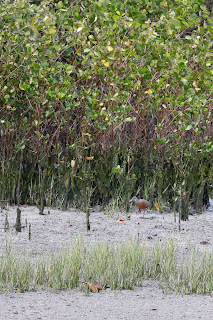After a little bit of shuffling with the itinerary for our time in Sao Luis, we decided to return to the mangroves around Raposa but this time cross the river as soon as we arrived, and check the mangroves before the tide dropped too much, and the Sunday tourists arrived.
This was an excellent decision as we immediately saw all the
Black Skimmers roosting on a near sandbar and we were able to get incredible
views of them, as well as when they were all flushed by a passing boat. The
wader composition was very much the same, and it was not until nearly the end
of the morning that we found an additional species to yesterday, with a super confiding
Least Sandpiper, always a joy to see this teeny species. A Barn Swallow that
flew down the mangrove river was also a nice surprise.
Walking round the mangroves we had a number of encounters
with the very elusive Little Wood Rail. Using playback we got a few brief
glimpses of a couple of individuals, but by the end of the morning a pair we
happily feeding on the fringes of the mangroves. Although we have seen this
species before, it was brief and nothing like the encounters we enjoyed here.
Another mangrove species that we got fantastic views of were the Scarlet Ibis,
with a group feeding very close the riverbank.
To round things off for the morning, I also had a Brazil tick in Red-breasted Meadowlark, a species I have seen before in Colombia, and then a fantastic mammal tick. While watching the Ibises, we noticed that we ourselves were being watched by a Crab-eating Raccoon, which was sat in the middle of the mud staring at us. I’ve never seen a raccoon before in Brazil, so this was extremely exciting. However once it noticed that it had been spotted, it ran back into the mangroves, flushing a Little Wood Rail as it did…
Raposa: Feral Pigeon, Common Ground Dove, Little Wood Rail, American Oystercatcher, Grey Plover, Wilson's Plover, Semipalmated Plover, Hudsonian Whimbrel, Ruddy Turnstone, Least Sandpiper, Short-billed Dowitcher, Spotted Sandpiper, Greater Yellowlegs, Willet, Grey-headed Gull, Large-billed Tern, Gull-billed Tern, Black Skimmer, Neotropic Cormorant, Great Egret, Snowy Egret, Little Blue Heron, Tricolored Heron, Yellow-crowned Night Heron, Scarlet Ibis, Black Vulture, Lesser Yellow-headed Vulture, Ringed Kingfisher, Green Kingfisher, Crested Caracara, Yellow-headed Caracara, Straight-billed Woodcreeper, Spotted Tody-Flycatcher, Brown-crested Flycatcher, Great Kiskadee, Rufous-browed Peppershrike, Grey-breasted Martin, White-winged Swallow, Barn Swallow, Purple-throated Euphonia, Red-breasted Blackbird, Bicolored Conebill, Crab-eating Raccoon,



















No comments:
Post a Comment